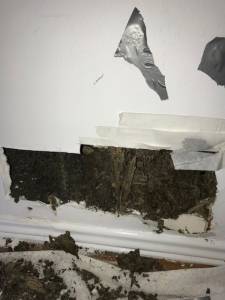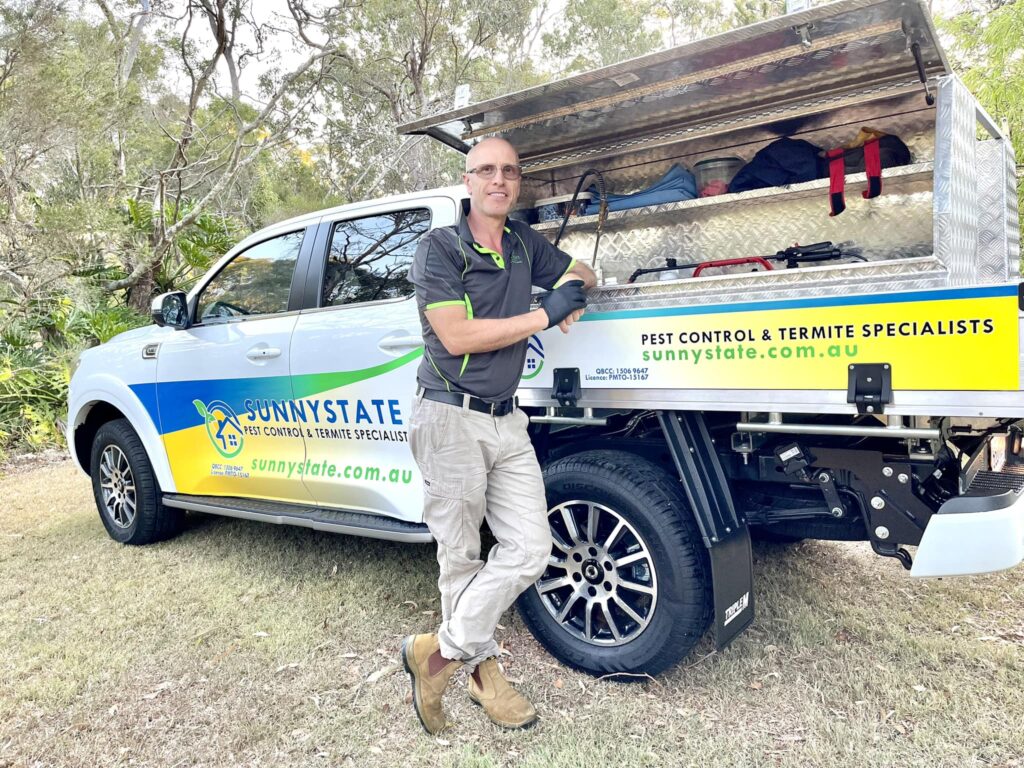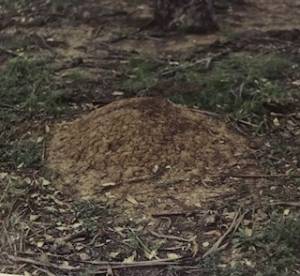Termite Nest
So you’ve found a termite nest and you want it destroyed, right? Well hold on just a minute, it’s not that simple. Let me explain what needs to be done when you find a termite nest in your garden. Getting rid of the nest is a simple process, but before this happens some thought needs to go into the situation.
Many people think that because there’s a termite nest in the garden, the termites are going to eat the house. There are many different species of termite and not all of them attack timber in service. When we use the term “timber in service” it’s basically wood that we use to build with.
Ok so let’s have a look at the process in destroying a termite nest and why we may need it. First if all we need to do a thorough termite inspection.


Termite Damage
Termite inspection
The termite inspection will give us the information we need to deal with the nest. The inspection will be carried out throughout the property and the gardens.
All of the internal and external walls are checked for any signs of termite activity. The roof void is a favourite hiding place for termites so this area also needs a thorough inspection.
The termite inspection generally starts outside checking all the garden beds and the exterior of the house. Then the internal inspection is carried out using a number of different inspection tools.
Termite Inspection Tools
The tools we use are a sounding stick, moisture meter and a thermal imaging camera. For me, the thermal imaging camera is a valuable inspection tool as we get to see behind the wall coverings.
We start off by walking around the house tapping all the wooden architraves and skirtings with the sounding stick. During this process, we’re listening for a difference in sound to detect termites.
The next step is to place the moisture meter on the wall to check for moisture. Moisture is a sure sign of termite activity or maybe even a leaking water pipe.
If water leaks are picked up behind the walls during the inspection. we recommende to have them seen to straight away. Remember, termites are attracted to moisture – they need it to survive. So the moisture meter is a great tool to use.
The last tool we use is the thermal imaging camera. This gives us a really good look at what’s behind the wall. If termites are in a wall cavity the thermal imaging camera will pick them up. The camera builds up an image of the surface from different temperatures.
So if there’s a termite nest or workings in a wall the camera will show the image and give us an idea of the size.
What’s In The Report
Once the termite inspection is completed, we’ll prepare the report and email it to you. The report will give a complete analysis of how well the property stands up to possible termite attack. The report will also give the you information on areas of concern that may need attention.
Any areas that are found during the inspection that may give termites easy access to your home will be included in the report. These areas can then be attended to, to help prevent future termite attack.
I always say to my customers to think of the termite inspection report as your friend. A thorough inspection and a well-written report can save a home from being attacked by hungry termites. A full report is essential before attempting to destroy a termite nest.
Before we destroy a termite nest
To destroy a termite nest with or without chemicals is crazy. If a termite nest is found within about 50 meters of the house there is a chance termites could be on the attack.
Some termite species such as Coptotermes Acinaciformis can attack a home from 50 meters away. That’s a serious long-range attack by little insects the size of an ant, but it happens often. This is one of the reasons we need to keep the termite nest intact.
Before we can destroy the termite nest we need to find out what species we are dealing with. We also need to find out whether or not the termites have made their way into the house.
If termites are active inside a house and there is a nest located in the garden somewhere we need to destroy it in a different way.
It’s not as simple as just kill the termite nest and move on. We first need to do a full termite inspection of the house. As explained above the termite inspection will give us all the information we need to correctly destroy the termite nest.
When a termite nest is located in a garden and there are active termites in the house, we use the termites in the house to destroy the termite nest.


Identify the termites
We first need to identify the termites. If they are the same species we can assume the outside nest is responsible for the attack on the house. At this point we have to assess how we destroy the outside termite nest.
We identify termites by collecting and examining the soldiers.
Once we know what species of termite we are dealing with an appropriate plan of action can be put into place. The last thing we want to do is destroy the nest found in the garden and leave the termites in the house. This type of situation happens a lot when homeowners decide to do their own termite treatment.
Some knowledge of termites and the surroundings are needed before we attempt to remove them. This is where the termite inspection is very important. Without it we are just shooting in the dark.
Destroying the termite nest
Now that we have all the facts we can destroy the termites.
Here are two scenarios of destroying a termite nest. The first will be when no termites are found in the house, and the second when there are termites in the house.
Scenario 1
The termite inspection has picked up that there is an active termite nest in the garden but no termites in the house. This is the easy scenario it’s as simple as flooding the nest with a termiticide.
This can be done with either a hand pressurized sprayer or a truck mounted machine. Both will effectively destroy the nest. If the nest is fairly large then the truck mounted system works best.
The amount of chemical used to destroy the nest will depend again on the size. For larger termite nests somewhere between 15-20 litres would be used.
Once the chemical has been injected into the nest that’s pretty much it, all the termites will die.
As a side note, when dealing with chemicals it’s important to use appropriate clothing and always read the label first. The label is like a pest controller’s bible and must be followed at all times regardless of how much experience you have.


Termite Mound Found in a Garden
Scenario 2
In scenario two the process is a little more involved and will require some monitoring over a few weeks.
So we have termites in the house and there’s a nest in the garden. As explained earlier, we need to use the termites in the house to destroy the nest. By first treating the termites in the house we will soon know if they are from the same nest found in the garden.
This is where some monitoring of the situation and some patience is needed. The main thing we want to do is get rid of the termites from the house. This is important as we want to limit the amount of damage to the house.
Depending on the time of year will depend on how long it will take to fully eradicate the termites. This is where patience is needed because during the winter months termites aren’t as active. Because they’re not so active during winter the elimination process takes longer depending on the size of the colony.
The Treatment
There are a few different ways to treat termites in a home. We can use baits, dust or foam. The baits are attached to walls or architraves where there are active termites. The termites then feed on the bait and over some time the bait is transferred to the rest of the colony.
When using either dust or foam to get rid of termites the product is applied directly to the workings. This is then passed throughout the colony causing the eventual demise of the entire colony.
Both methods work very well and it’s up to your termite professional to decide which they deem best for the situation.
Once the chemical has been applied the termites need to be left to unknowingly pass the poison back to the main colony. As mentioned earlier this is where the monitoring takes place. This is usually over 3-4 weeks again depending on the time of year.
Once the termites have been eliminated from inside the house the nest in the garden can be checked. If the nest has also been destroyed then we can safely say the termites that were in the house were from the nest in the garden.
If on the other hand the nest is still active and we are sure there are no termites remaining in the house. Then the nest can then be flooded with an appropriate termiticide. And that’s how you get rid of termites.
Barrier treatment
Where live termites are located inside a house we recommend installing a full termite barrier around the house. This will help to protect the house from future termite attack.
During a termite inspection, checks will be made to ascertain whether or not an active treatment is in place around the home. If there is not an active termite management system in place it will have to be marked in the report as essential.
Conclusion
So now you can see the importance of not just destroying a termite nest but also the importance of the termite inspection.
Termites are very clever little insects and to properly manage them you need to think as they do. Having a sound understanding of the feeding habits of the many different species of termite is also very important.
Using an experienced pest control company like Sunnystate Pest Control to deal with a termite issue is paramount. Termites can destroy a home if left untreated so don’t try it yourself. It’s just not worth the risk.
The most effective way to keep a home safe from termites is to have an annual termite inspection carried out. Along with an inspection it is recommended that all homes have an adequate termite management system put in place.
This post is designed to give you a better understanding of why we deal with termites in different ways. Anyone with concerns about termites simply reply below or send us an email.
Don’t let termites ruin your home! Call Sunnystate Pest Control today!

